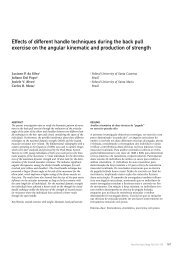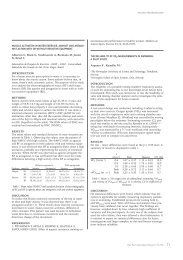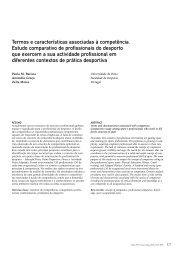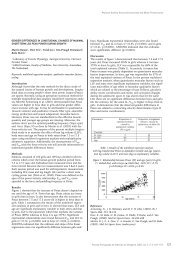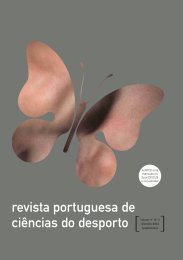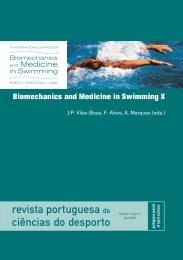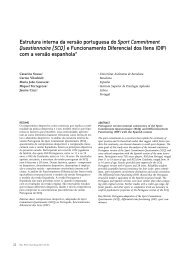adapted swimming sports and rehabilitation
adapted swimming sports and rehabilitation
adapted swimming sports and rehabilitation
Create successful ePaper yourself
Turn your PDF publications into a flip-book with our unique Google optimized e-Paper software.
in DWR than in WW was attributable to the greater range of<br />
motion at the knee joint in DWR. Experiments of motion<br />
analysis that are synchronized to EMG are required to elucidate<br />
this aspect more precisely.<br />
The second objective of this study was investigation of the<br />
intervention effects of UF exercise on balance ability in elderly.<br />
For that purpose, we designed a once-a-week water exercise<br />
program lasting 12 weeks <strong>and</strong> established NW <strong>and</strong> UF exercise<br />
groups. The body-sway distance <strong>and</strong> area were increased in<br />
NW, but the body-sway area was decreased in UF <strong>and</strong> the t<strong>and</strong>em<br />
walk time of 10 steps was decreased in UF.<br />
It is widely acknowledged that body-sway as a static balance<br />
ability reflects the center of gravity (COG) during st<strong>and</strong>ing (5).<br />
T<strong>and</strong>em walking is often used as a dynamic balance ability (2).<br />
In the present study, the static balance declined in NW, but<br />
static <strong>and</strong> dynamic balance improved in UF. No studies have<br />
reported the decline of body-sway through exercising for the<br />
elderly. Simmons et al. (8), who reported enhancement of functional<br />
reach in water exercise group, explained two characteristics<br />
during water exercise. First, the buoyancy provided by<br />
water can be considered destabilizing because it will tend to lift<br />
a subject up. Second, because water exercise was conducted for<br />
a group, this created turbulence, which might have increased<br />
the variability of the factors influencing each participant’s<br />
movement. Destabilizing buoyancy <strong>and</strong> turbulence that<br />
occurred during water exercise might have affected the<br />
increased body-sway distance <strong>and</strong> area in NW.<br />
Improvement of body-sway in women with lower extremity<br />
arthritis was demonstrated in water exercises (9). In the present<br />
study, UF improved the body-sway area. T<strong>and</strong>em walking also<br />
improved only the UF group. Experiment 1 revealed that BF<br />
mEMG increased significantly in DWR compared to WW. The<br />
high stimulus of the BF during DWR was inferred to improve<br />
the balance ability in UF. Other possibilities are coordination<br />
between the legs <strong>and</strong> body or adjustment of body balance, as<br />
seen in Tai Chi Chuan (1), but further research is required.<br />
The static <strong>and</strong> dynamic balance ability improved in UF in the<br />
present study. In general, the balance ability declines with age;<br />
it is an important function that prevents fall accidents because<br />
it is associated with postural control (11). Results of the present<br />
study suggest that UF exercise might be useful for elderly<br />
persons to prevent fall accidents because the balance ability<br />
was improved after 12 weeks’ intervention.<br />
CONCLUSION<br />
This study suggests that UF exercise can improve the balance<br />
abilities of elderly persons. It might be affected by the high<br />
muscle activity of BF during DWR. Furthermore, because balance<br />
abilities were improved after 12 weeks, UF exercise in the<br />
water might be useful to prevent elderly persons’ fall accidents.<br />
ACKNOWLEDGEMENTS<br />
Support of the staff of the Swim Laboratory at the University<br />
of Tsukuba is greatly appreciated. We also thank all 9 young<br />
men of Exp. 1 <strong>and</strong> 14 elderly men <strong>and</strong> women of Exp. 2 for<br />
participating enthusiastically in this study.<br />
REFERENCES<br />
1. Jin C, Watanabe K (2003). The practice of Tai Chi Chuan in<br />
middle <strong>and</strong> elderly person <strong>and</strong> its effect to static <strong>and</strong> dynamic<br />
postural stability. Jpn J Phys Fitness Sports Med, 52: 369-80, in<br />
Japanese<br />
ADAPTED SWIMMING SPORTS AND REHABILITATION<br />
2. Medell JL, Alex<strong>and</strong>er NB (2000). A clinical measure of maximal<br />
<strong>and</strong> rapid stepping in older women. Journal of<br />
Gerontology: Medical Sciences, 55A(8): M429-33<br />
3. Miyoshi T, Shirota T, Yamamoto S, Nakazawa K, Akai M<br />
(2004). Effect of the walking speed to the lower limb joint<br />
angular displacements, joint moments <strong>and</strong> ground reaction<br />
forces during walking in water. Disability <strong>and</strong> Rehabilitation,<br />
26(12): 724-32<br />
4. Moening D, Scheidt A, Shepardson L, Davies GJ (1993).<br />
Biomechanical comparison of water running <strong>and</strong> treadmill running.<br />
Isokinetics <strong>and</strong> Exercise Science, 3(4): 207-15<br />
5. Murray MP, Seireg A, Scholz RC (1967). Center of gravity,<br />
center of pressure, <strong>and</strong> supportive forces during human activities.<br />
J Appl Physiol, 23(6): 831-8<br />
6. Nilsson J, Thorstensson A, Halbertsma J (1985). Changes in<br />
leg movements <strong>and</strong> muscle activity with speed of locomotion<br />
<strong>and</strong> mode of progression in humans. Acta Physiol Sc<strong>and</strong>, 123:<br />
457-75<br />
7. Reilly T, Dowzer CN, Cable NT (2003). The physiology of<br />
deep-water running. Journal of Sports Sciences, 21: 959-72<br />
8. Simmons V, Hansen PD (1996). Effectiveness of water exercise<br />
on postural mobility in the well elderly: An experimental<br />
study on balance enhancement. Journal of Gerontology:<br />
Medical Sciences, 51A(5): M233-8<br />
9. Suomi R, Koceja DM (2000). Postural sway characteristics in<br />
women with lower extremity arthritis before <strong>and</strong> after an<br />
aquatic exercise intervention. Arch Phys Med Rehabil, 81: 780-<br />
5<br />
10. Svedenhag J, Seger J (1992). Running on l<strong>and</strong> <strong>and</strong> in water:<br />
comparative exercise physiology. Med Sci Sports Exerc, 24(10):<br />
1155-60<br />
11. Woollacott M (1993). Age-related changes in posture <strong>and</strong><br />
movement. The Journal of Gerontology, 48: 56-60<br />
12. Yoneda T, Muraki T, Taketomi Y (1994). Influence of aging<br />
on st<strong>and</strong>ing balance. Bulletin of Allied Medical Sciences, Kobe<br />
10: 61-68.<br />
DURATION OF ONE UNIT (80KCAL) DURING TREADMILL WALKING<br />
IN WATER<br />
Kumiko Ono1 , Kazuki Nishimura1 , Sho Onodera2 1Graduate School, Kawasaki University of Medical Welfare, Kurashiki,<br />
Japan<br />
2Kawasaki University of Medical Welfare, Kurashiki, Japan.<br />
The number of Japanese people diagnosed with diabetes has<br />
been increasing. Epidemiological <strong>and</strong> intervention studies of<br />
endurance exercise training strongly support its efficacy for<br />
improving diabetes. The purpose of the present study was to<br />
make clear the difference of duration per expended one unit<br />
(80kcal) during treadmill walking in water between younger<br />
<strong>and</strong> older people. We would get the st<strong>and</strong>ard data by using non<br />
diabetes people. Ten healthy young men <strong>and</strong> eight healthy<br />
women participated in this study. Subjects walked at 1, 2 <strong>and</strong><br />
3km/h (30.3°C). The duration of exercise that expended one<br />
unit of energy was calculated from VO 2. Younger <strong>and</strong> older<br />
people’s calculated results were 41’39’’ <strong>and</strong> 39’44’’ (1km/h),<br />
33’22’’ <strong>and</strong> 31’56’’ (2km/h) <strong>and</strong> 24’51’’ <strong>and</strong> 24’56’’ (3km/h).<br />
There was no difference due to the difference of the age in one<br />
unit. It might be suggested that it becomes possible to pre-<br />
Rev Port Cien Desp 6(Supl.2) 351-357 353



